I remember being intrigued and confused when I heard my biology high school biology teacher talk about stromatolites, the oldest fossils found on Earth. I wanted to know more about the apartment building, as she described the stromatolites, of the oldest known bacteria that inhabited Earth three and a half billion years ago. Earth is four and a half billion years old, so it took tone billion years for lift hat could preserve fossils to exist. I wanted to see these structures, to feel them. I would have to go to Australia, she said, since that is where the stromatolites are found in modern times. And with that, the short lesson on stromatolites ended. I remained intrigued by the structures left by this bacteria in a few lakes and oceanic coasts of the world.
Imagine my surprise when we found at Torres del Paine that some of its glacial lakes have very similar structures called Thrombolites! Thrombolites are very similar to strombolites and are created by the same type of organisms. We stopped at an overlook in the National Park to take pictures of the mountains and found a sign describing the thrombolites on Lago Sarmiento. Most people passing by do not pay attention to these amazing structures, as they go to see the mountains, not strange life. I was an exception, and asked our guide to please take us to the edge of Lago Sarmiento so see and feel the thrombolites. He seemed surprised by the request, but took us there at the end of the day when we were heading back to Puerto Natales.
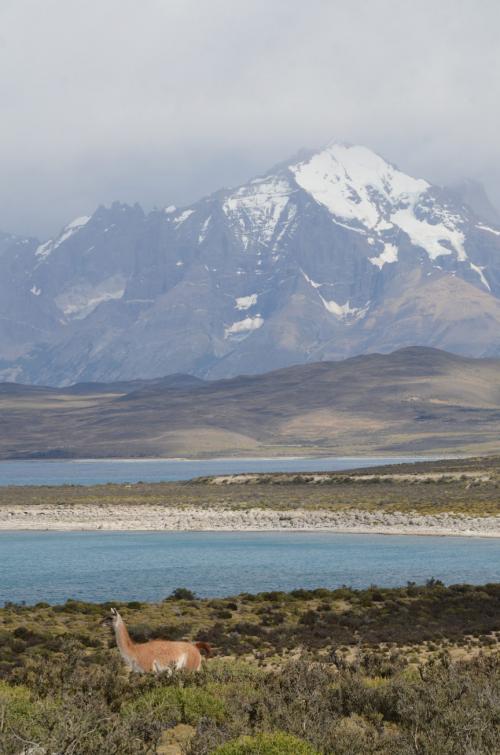 A guanaco in front of Laguna Sarmiento at Torres del Paine. Thrombolites can be seen as the white shore of the lake.
A guanaco in front of Laguna Sarmiento at Torres del Paine. Thrombolites can be seen as the white shore of the lake.
Stromatolites and Thrombolites are structures generated in shallow and salty waters by cyanobacteria (blue green algae) that are able to perform photosynthesis like regular plants. They are considered bacteria and not plants because they do not have a nucleus. This bacteria produce a film on which sediments and calcium carbonate stick, forming the stromatolites and thrombolites. You are familiar with calcium carbonate because that is what forms seashells. The live bacteria are present in the surface of the structure, and keep adding sediments and calcium carbonate at a rate of less than 1 millimeter per year.
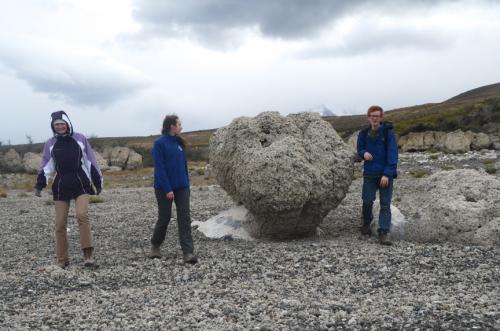 Claire, Anna and Luke strolling among old Thrombolites at Laguna Sarmiento. No bacteria is alive in the thrombolites that are not in water
Claire, Anna and Luke strolling among old Thrombolites at Laguna Sarmiento. No bacteria is alive in the thrombolites that are not in water
The stromatolites are laminated structures, and therefore have a smooth surface, while the thrombolites are called aggregated, therefore are very porous. At one time thrombolites were thought to be stromatolites in which other organisms had made holes, but we now think they are different structures created by similar bacteria.
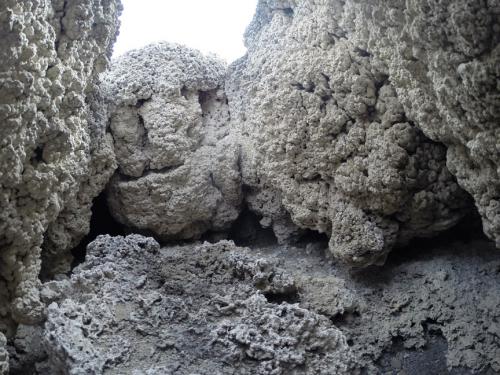 The old and death thrombolites had large cavities among them. Large enough for one to go inside these caves.
The old and death thrombolites had large cavities among them. Large enough for one to go inside these caves.
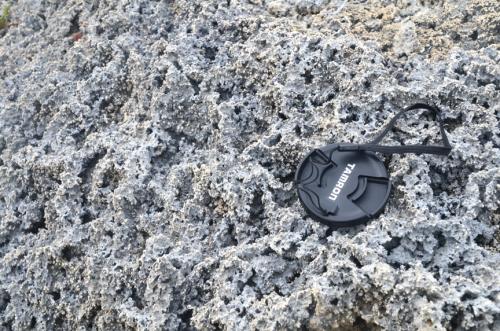 A camera cap that has 62mm of diameter on top of a thrombolite to show the scale of its structures.
A camera cap that has 62mm of diameter on top of a thrombolite to show the scale of its structures.
Lago Sarmiento, like the few other bodies of water that have these structures, is very salty and alkaline. Alkaline is the opposite of acidic. Acidity and alkalinity are measured with a scale called PH, and goes from close to 0 (extremely acidic) to 14 (extremely alkaline). To give you an idea of these values, battery acid is 1, your stomach acids are between 1 and 2, vinegar is 2.4 to 3.4, lemon juice is 2.3, and pure water is PH=7. Moving to alkaline substances we have sea water between 7.3 and 8.21, baking soda at 8, borax at 9.2 , Milk of magnesia, an antacid, is 10.5, while soda lye is 14.0. The water at Lago Sarmiento has a PH of 9!
Stromatolites and thrombolites can be formed in these waters because very few organisms can survive in these waters. The cyanobacteria can grow without being perturbed by other organisms, like snails that would eat the film created by the bacteria on which sediments and calcium carbonate stick. Very few areas in the world can produce this conditions. The lake or sea coast needs to have more evaporation than precipitation fort heater to be so salty. Lago Sarmiento also has a layer of sediments below the water with a lot of calcium carbonate, necessary for the Thrombolites and the high PH. The cyanobacteria need shallow waters to form the thrombolites and stromatolites so they can receive enough sunlight fordoing photosynthesis.
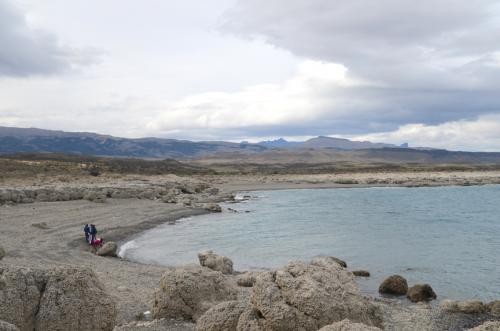 The JASE team at a beach at Lago Sarmiento. The shore is covered with dead thrombolites, while thromoblites are alive under the shallow waters of this special lake.
The JASE team at a beach at Lago Sarmiento. The shore is covered with dead thrombolites, while thromoblites are alive under the shallow waters of this special lake.
The thromboliotes at Lago Sarmiento are not as old as the 3.5 billion year old stromatolite my talked about long ago; they are thought to be just 10000 years old. It was great to be able to see, feel and walk among this structures that tell stories of times past.


Comments